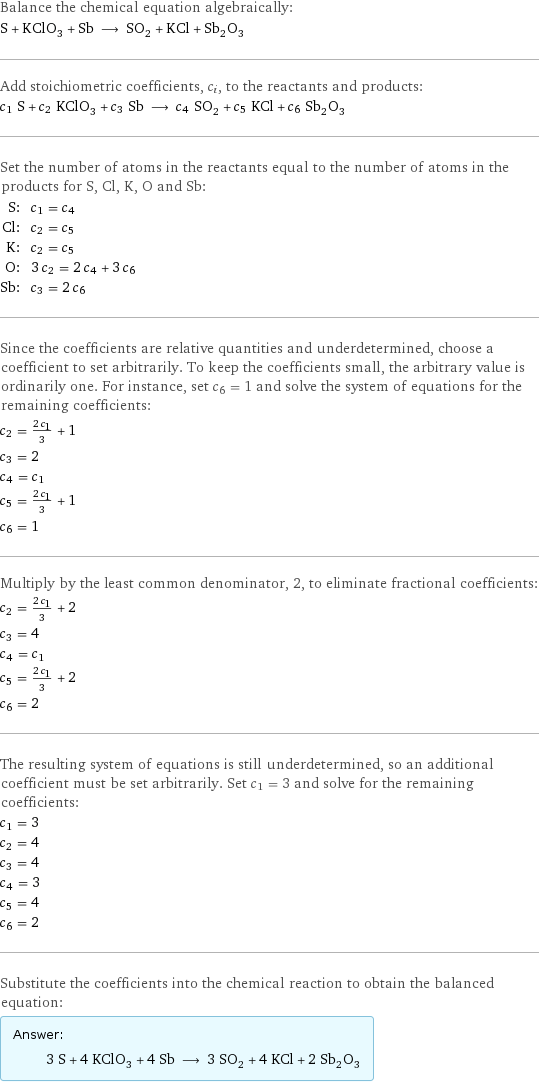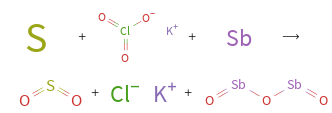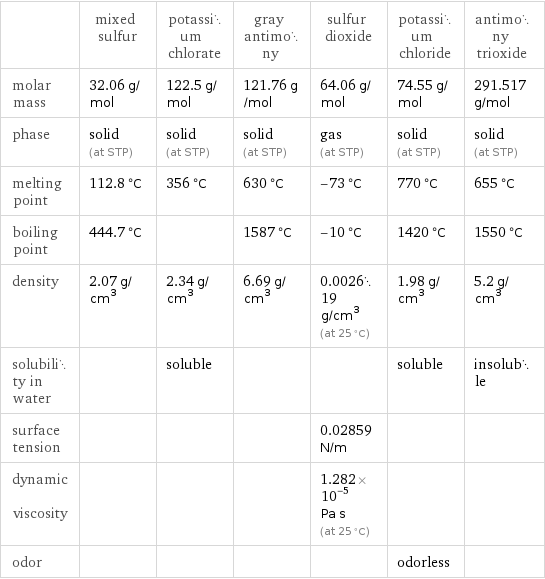Input interpretation

S mixed sulfur + KClO_3 potassium chlorate + Sb gray antimony ⟶ SO_2 sulfur dioxide + KCl potassium chloride + Sb_2O_3 antimony trioxide
Balanced equation

Balance the chemical equation algebraically: S + KClO_3 + Sb ⟶ SO_2 + KCl + Sb_2O_3 Add stoichiometric coefficients, c_i, to the reactants and products: c_1 S + c_2 KClO_3 + c_3 Sb ⟶ c_4 SO_2 + c_5 KCl + c_6 Sb_2O_3 Set the number of atoms in the reactants equal to the number of atoms in the products for S, Cl, K, O and Sb: S: | c_1 = c_4 Cl: | c_2 = c_5 K: | c_2 = c_5 O: | 3 c_2 = 2 c_4 + 3 c_6 Sb: | c_3 = 2 c_6 Since the coefficients are relative quantities and underdetermined, choose a coefficient to set arbitrarily. To keep the coefficients small, the arbitrary value is ordinarily one. For instance, set c_6 = 1 and solve the system of equations for the remaining coefficients: c_2 = (2 c_1)/3 + 1 c_3 = 2 c_4 = c_1 c_5 = (2 c_1)/3 + 1 c_6 = 1 Multiply by the least common denominator, 2, to eliminate fractional coefficients: c_2 = (2 c_1)/3 + 2 c_3 = 4 c_4 = c_1 c_5 = (2 c_1)/3 + 2 c_6 = 2 The resulting system of equations is still underdetermined, so an additional coefficient must be set arbitrarily. Set c_1 = 3 and solve for the remaining coefficients: c_1 = 3 c_2 = 4 c_3 = 4 c_4 = 3 c_5 = 4 c_6 = 2 Substitute the coefficients into the chemical reaction to obtain the balanced equation: Answer: | | 3 S + 4 KClO_3 + 4 Sb ⟶ 3 SO_2 + 4 KCl + 2 Sb_2O_3
Structures

+ + ⟶ + +
Names

mixed sulfur + potassium chlorate + gray antimony ⟶ sulfur dioxide + potassium chloride + antimony trioxide
Equilibrium constant
![Construct the equilibrium constant, K, expression for: S + KClO_3 + Sb ⟶ SO_2 + KCl + Sb_2O_3 Plan: • Balance the chemical equation. • Determine the stoichiometric numbers. • Assemble the activity expression for each chemical species. • Use the activity expressions to build the equilibrium constant expression. Write the balanced chemical equation: 3 S + 4 KClO_3 + 4 Sb ⟶ 3 SO_2 + 4 KCl + 2 Sb_2O_3 Assign stoichiometric numbers, ν_i, using the stoichiometric coefficients, c_i, from the balanced chemical equation in the following manner: ν_i = -c_i for reactants and ν_i = c_i for products: chemical species | c_i | ν_i S | 3 | -3 KClO_3 | 4 | -4 Sb | 4 | -4 SO_2 | 3 | 3 KCl | 4 | 4 Sb_2O_3 | 2 | 2 Assemble the activity expressions accounting for the state of matter and ν_i: chemical species | c_i | ν_i | activity expression S | 3 | -3 | ([S])^(-3) KClO_3 | 4 | -4 | ([KClO3])^(-4) Sb | 4 | -4 | ([Sb])^(-4) SO_2 | 3 | 3 | ([SO2])^3 KCl | 4 | 4 | ([KCl])^4 Sb_2O_3 | 2 | 2 | ([Sb2O3])^2 The equilibrium constant symbol in the concentration basis is: K_c Mulitply the activity expressions to arrive at the K_c expression: Answer: | | K_c = ([S])^(-3) ([KClO3])^(-4) ([Sb])^(-4) ([SO2])^3 ([KCl])^4 ([Sb2O3])^2 = (([SO2])^3 ([KCl])^4 ([Sb2O3])^2)/(([S])^3 ([KClO3])^4 ([Sb])^4)](../image_source/0f424cc6cf0df1f3d8dd3b1e7ae3475b.png)
Construct the equilibrium constant, K, expression for: S + KClO_3 + Sb ⟶ SO_2 + KCl + Sb_2O_3 Plan: • Balance the chemical equation. • Determine the stoichiometric numbers. • Assemble the activity expression for each chemical species. • Use the activity expressions to build the equilibrium constant expression. Write the balanced chemical equation: 3 S + 4 KClO_3 + 4 Sb ⟶ 3 SO_2 + 4 KCl + 2 Sb_2O_3 Assign stoichiometric numbers, ν_i, using the stoichiometric coefficients, c_i, from the balanced chemical equation in the following manner: ν_i = -c_i for reactants and ν_i = c_i for products: chemical species | c_i | ν_i S | 3 | -3 KClO_3 | 4 | -4 Sb | 4 | -4 SO_2 | 3 | 3 KCl | 4 | 4 Sb_2O_3 | 2 | 2 Assemble the activity expressions accounting for the state of matter and ν_i: chemical species | c_i | ν_i | activity expression S | 3 | -3 | ([S])^(-3) KClO_3 | 4 | -4 | ([KClO3])^(-4) Sb | 4 | -4 | ([Sb])^(-4) SO_2 | 3 | 3 | ([SO2])^3 KCl | 4 | 4 | ([KCl])^4 Sb_2O_3 | 2 | 2 | ([Sb2O3])^2 The equilibrium constant symbol in the concentration basis is: K_c Mulitply the activity expressions to arrive at the K_c expression: Answer: | | K_c = ([S])^(-3) ([KClO3])^(-4) ([Sb])^(-4) ([SO2])^3 ([KCl])^4 ([Sb2O3])^2 = (([SO2])^3 ([KCl])^4 ([Sb2O3])^2)/(([S])^3 ([KClO3])^4 ([Sb])^4)
Rate of reaction
![Construct the rate of reaction expression for: S + KClO_3 + Sb ⟶ SO_2 + KCl + Sb_2O_3 Plan: • Balance the chemical equation. • Determine the stoichiometric numbers. • Assemble the rate term for each chemical species. • Write the rate of reaction expression. Write the balanced chemical equation: 3 S + 4 KClO_3 + 4 Sb ⟶ 3 SO_2 + 4 KCl + 2 Sb_2O_3 Assign stoichiometric numbers, ν_i, using the stoichiometric coefficients, c_i, from the balanced chemical equation in the following manner: ν_i = -c_i for reactants and ν_i = c_i for products: chemical species | c_i | ν_i S | 3 | -3 KClO_3 | 4 | -4 Sb | 4 | -4 SO_2 | 3 | 3 KCl | 4 | 4 Sb_2O_3 | 2 | 2 The rate term for each chemical species, B_i, is 1/ν_i(Δ[B_i])/(Δt) where [B_i] is the amount concentration and t is time: chemical species | c_i | ν_i | rate term S | 3 | -3 | -1/3 (Δ[S])/(Δt) KClO_3 | 4 | -4 | -1/4 (Δ[KClO3])/(Δt) Sb | 4 | -4 | -1/4 (Δ[Sb])/(Δt) SO_2 | 3 | 3 | 1/3 (Δ[SO2])/(Δt) KCl | 4 | 4 | 1/4 (Δ[KCl])/(Δt) Sb_2O_3 | 2 | 2 | 1/2 (Δ[Sb2O3])/(Δt) (for infinitesimal rate of change, replace Δ with d) Set the rate terms equal to each other to arrive at the rate expression: Answer: | | rate = -1/3 (Δ[S])/(Δt) = -1/4 (Δ[KClO3])/(Δt) = -1/4 (Δ[Sb])/(Δt) = 1/3 (Δ[SO2])/(Δt) = 1/4 (Δ[KCl])/(Δt) = 1/2 (Δ[Sb2O3])/(Δt) (assuming constant volume and no accumulation of intermediates or side products)](../image_source/8ed669abee0c2568c156a6159c8a93fe.png)
Construct the rate of reaction expression for: S + KClO_3 + Sb ⟶ SO_2 + KCl + Sb_2O_3 Plan: • Balance the chemical equation. • Determine the stoichiometric numbers. • Assemble the rate term for each chemical species. • Write the rate of reaction expression. Write the balanced chemical equation: 3 S + 4 KClO_3 + 4 Sb ⟶ 3 SO_2 + 4 KCl + 2 Sb_2O_3 Assign stoichiometric numbers, ν_i, using the stoichiometric coefficients, c_i, from the balanced chemical equation in the following manner: ν_i = -c_i for reactants and ν_i = c_i for products: chemical species | c_i | ν_i S | 3 | -3 KClO_3 | 4 | -4 Sb | 4 | -4 SO_2 | 3 | 3 KCl | 4 | 4 Sb_2O_3 | 2 | 2 The rate term for each chemical species, B_i, is 1/ν_i(Δ[B_i])/(Δt) where [B_i] is the amount concentration and t is time: chemical species | c_i | ν_i | rate term S | 3 | -3 | -1/3 (Δ[S])/(Δt) KClO_3 | 4 | -4 | -1/4 (Δ[KClO3])/(Δt) Sb | 4 | -4 | -1/4 (Δ[Sb])/(Δt) SO_2 | 3 | 3 | 1/3 (Δ[SO2])/(Δt) KCl | 4 | 4 | 1/4 (Δ[KCl])/(Δt) Sb_2O_3 | 2 | 2 | 1/2 (Δ[Sb2O3])/(Δt) (for infinitesimal rate of change, replace Δ with d) Set the rate terms equal to each other to arrive at the rate expression: Answer: | | rate = -1/3 (Δ[S])/(Δt) = -1/4 (Δ[KClO3])/(Δt) = -1/4 (Δ[Sb])/(Δt) = 1/3 (Δ[SO2])/(Δt) = 1/4 (Δ[KCl])/(Δt) = 1/2 (Δ[Sb2O3])/(Δt) (assuming constant volume and no accumulation of intermediates or side products)
Chemical names and formulas

| mixed sulfur | potassium chlorate | gray antimony | sulfur dioxide | potassium chloride | antimony trioxide formula | S | KClO_3 | Sb | SO_2 | KCl | Sb_2O_3 Hill formula | S | ClKO_3 | Sb | O_2S | ClK | O_3Sb_2 name | mixed sulfur | potassium chlorate | gray antimony | sulfur dioxide | potassium chloride | antimony trioxide IUPAC name | sulfur | potassium chlorate | antimony | sulfur dioxide | potassium chloride | oxo-oxostibanyloxystibane
Substance properties

| mixed sulfur | potassium chlorate | gray antimony | sulfur dioxide | potassium chloride | antimony trioxide molar mass | 32.06 g/mol | 122.5 g/mol | 121.76 g/mol | 64.06 g/mol | 74.55 g/mol | 291.517 g/mol phase | solid (at STP) | solid (at STP) | solid (at STP) | gas (at STP) | solid (at STP) | solid (at STP) melting point | 112.8 °C | 356 °C | 630 °C | -73 °C | 770 °C | 655 °C boiling point | 444.7 °C | | 1587 °C | -10 °C | 1420 °C | 1550 °C density | 2.07 g/cm^3 | 2.34 g/cm^3 | 6.69 g/cm^3 | 0.002619 g/cm^3 (at 25 °C) | 1.98 g/cm^3 | 5.2 g/cm^3 solubility in water | | soluble | | | soluble | insoluble surface tension | | | | 0.02859 N/m | | dynamic viscosity | | | | 1.282×10^-5 Pa s (at 25 °C) | | odor | | | | | odorless |
Units
